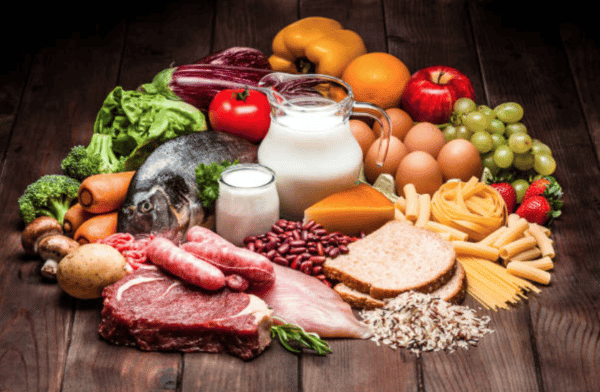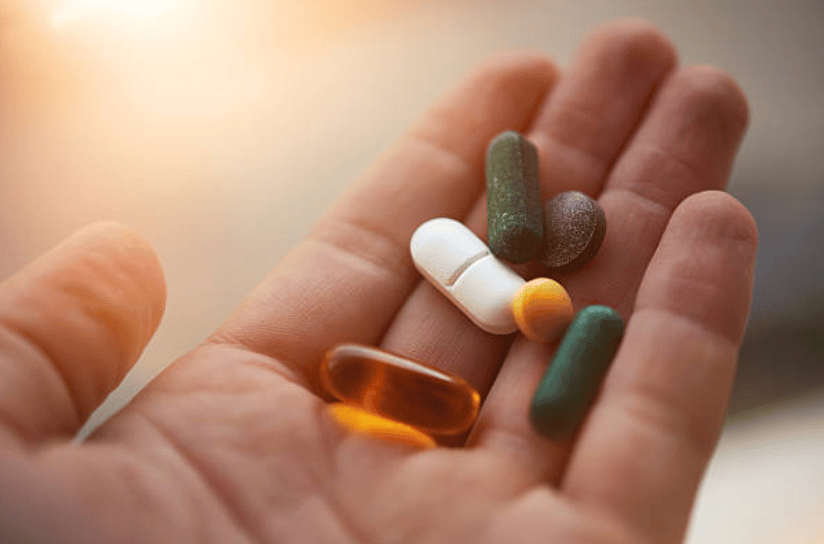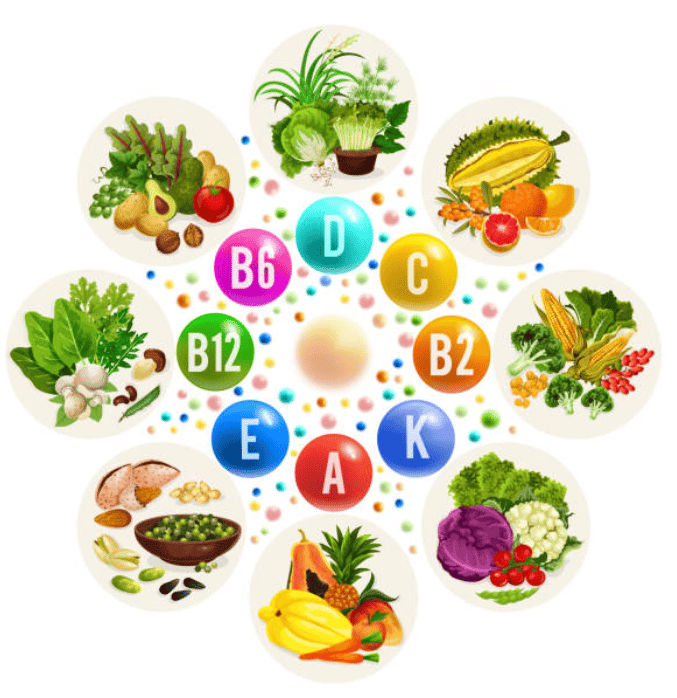To function properly our body needs nutrients. These nutrients contain 2 families which are the macronutrients and the micronutrients which are essential to our health. It is therefore necessary to eat healthily, varied and have a balanced diet to give our body the good recommended daily intake it needs according to the energy expenditure of the day that is going to pass. In this way, the body will be ready for the efforts and activities of daily life but also for the weight training that we will put it through. The Recommended Dietary Allowance or RDA, is the sufficient amount of different nutrients needed to ensure the proper functioning of our human body.
Zoom in on macronutrients and micronutrients to find out more about what we need to eat.
What are macronutrients?
Macronutrients include proteins, carbohydrates and fats. The energy our body needs to function comes from this fuel. When we practice bodybuilding, the proper distribution of macronutrients is essential to our progress whether it is for muscle gain or fat loss or even without a specific goal. As soon as you adopt this method of calculation, you will be more efficient in your sports activity.
The basic rules are simple, if you eat more calories than you expend then you will gain weight, and conversely if you consume less calories you will lose weight but again, it is not enough to stop eating to lose weight but to calculate your macros properly so as not to be deficient in anything and therefore adopt a correct diet that is good for your health.
Protein:
1 gram of protein equals 4 calories. Protein-rich foods are:
eggs, fish (tuna, salmon), red or white meat, dairy products (milk products), certain legumes (pulses), cereal-based foods, soybeans, nuts, spinach and lentils...
Proteins are several amino acids assembled together and are 20 in number so the following 10 essential amino acids:
arginine, histidine, isoleucine, leucine, lysine, methionine, phenylalanine, threonine, valine, tryptophan.
Depending on the activity and sport practice, protein consumption varies between 0.8 and 2 grams per kilo of body weight. Remember that it is not necessary to consume more because it could tire our kidneys and would therefore be counterproductive. Moreover, people who already have kidney problems should watch their consumption.
What are proteins used for?
Proteins are used to regenerate cells and muscle fibres. They participate in the renewal of nails and hair. They provide digestive enzymes, hormones and antibodies among others and are therefore important for the proper functioning of our muscles. Their functions can be structural or metabolic. The first one includes what we have mentioned above and the second one is responsible for the chemical reactions essential to the functioning of the body.
Carbohydrates
1 gram of carbohydrate equals 4 calories. Carbohydrates include foods such as flour, sugar, rice and fruit juice....
They give energy to the muscles and the brain and every athlete must consume them. They are transformed into glucose and the body uses part of them as direct energy and the other part is stored as glycogen in the muscles and liver.
Carbohydrates also include certain vegetables that also contain prebiotics and probiotics that our bodies need for good health.
For example oatmeal, Whole grains or artichokes contain fibers and prebiotics good for the intestinal flora. This family of carbohydrates contains all the dietary fibres that slow down digestion and protect us from constipation, regulate cholesterol and fight against certain cancers. They are the ones that give us the impression of being full because they swell up in our stomach and thus regulate transit.
Greek yoghurt (or cheese) contains live micro-organisms (probiotics) which are also good for the flora. Some bodybuilders consume these probiotics in the form of food supplements. Indeed, according to their objectives, they have to eat more than sedentary people and this can weaken their intestinal flora. This supplementation aids in digestion and allows for better assimilation of nutrients.
Lipids
1 gram of fat equals 9 calories. Lipids include egg yolks, avocados, olives, dried fruits....
Lipids provide energy and help in the transport of certain vitamins: vitamins A, D, E and K, which have a satiating effect. Vitamin D, also known as the sunshine vitamin, is found in dark chocolate or sardines (or mackerel) and is also absorbed by the skin through the sun's UV rays.
Lipids contain fatty acids:
Saturated fatty acids: example butter, coconut oil
Monounsaturated, polyunsaturated: e.g. olive oil, rapeseed, avocado, salmon (omega 3 and 6)
Trans acids: fried foods and margarines
Macronutrients are sources of energy that the body will use immediately or in the longer term. Either way, they are absolutely necessary for our bodies to function properly.
What are micronutrients?
Micronutrients are vitamins and minerals, trace elements and essential fatty acids.
Unlike macronutrients, micronutrients do not contain calories but are absolutely essential for the body's biochemical processes. They are there in particular for the renewal of the cells, the elimination of toxins or fight against ageing. They are mainly consumed in fresh fruits and vegetables.
Some micronutrients are called "essential". This means that they cannot be synthesized by the body and must be supplied by the diet. A deficiency of certain so-called essential foods will inevitably lead to cardiovascular or other diseases.
Vitamins
Water-soluble vitamins (B vitamins, C vitamins) provided by fruits and vegetables are waterlogged
Fat-soluble vitamins (vitamins A, D, E and K) are mainly supplied by lipids.
Our body does not produce them, so eating a balanced diet or taking supplements will provide our body with everything it needs to fight fatigue and improve its immune system. There are 13 types of vitamins that will have beneficial effects.
Mineral salts are a category of micro-nutrients derived from rocks found in food in their natural form and are 7 in number. Iron helps to make red blood cells that carry oxygen in the blood. Another example is copper, which helps the heart function properly and maintains cartilage. There are obviously others but I will not mention them all.
Trace elements
And finally the trace elements total 15 varieties and here are some of them: sodium, calcium, selenium, copper, gold, iron, fluorine, zinc, phosphorus, manganese and magnesium, a natural anti-stress that regulates blood sugar.
Oligo means little, they become dangerous for health if we consume them in too large quantities.
Micronutrients, unlike macros, do not provide energy but are essential for our vital functions. The distribution is about 98% of water and macronutrients and 2% of micronutrients. The latter are mandatory for our dietary balance.
Conclusion
Normally, our diet allows us to provide our body with all the necessary necessary vitamins and minerals. Unfortunately, at present, the quality of the food we eat is altered by the industrialization of our foodstuffs. Indeed, the industrial treatments considerably reduce the contribution of these vitamins and minerals.
Pollution and smoking deteriorate or even destroy these vitamins and some drug treatments reduce the absorption of certain micronutrients.
In addition, weight trainers and sports enthusiasts need more magnesium, zinc and other vitamins. Intense and prolonged exercise fatigues the muscle. If there is a deficiency of vitamins and minerals, the bones can be weakened and injuries more frequent. Overexertion or pregnancy can also lead to a need for more vitamins and minerals.
This is why it is recommended that athletes and people who are not physically active take food supplements to compensate for any vitamin deficiency. However, be careful not to go overboard either. Micronutrition must be adapted to each individual, as must the calculation of recommended daily allowances.
Before deciding to supplement, it may be wise to do a health check-up by asking your doctor for a blood test or urine test.
And there you have it, you now know what macros and micronutrients are, essential elements for our body.
No more excuses to stay healthy!
As an expert in nutrition, I have designed special formulas for you to food programmes to help you get the look you want.
Other articles to read :
The muscles of the body and the different muscle groups











2 Comments
thank you for allowing us to learn about nutrition coach that's the point I can't keep up because I like to eat too much
With pleasure, Tom. Diet is essential if you want to progress. Keep going